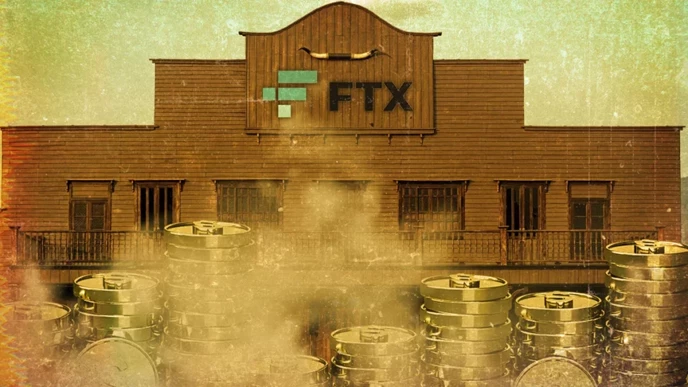The Crypto Wild West! Are TradFi Markets Really That Different??

Some would say that the cryptocurrency market has a shady reputation due to its price volatility, volume of scams, and high-profile company bankruptcies.
No wonder it's been dubbed the “crypto wild west”.
In fact, in 2022 alone, crypto losses accounted for US $3.7 billion – up a staggering 58% on the previous year – but is this really that much different to traditional finance??
Today we are going to compare some of the most prominent hacks and frauds that took place in both TradFi and crypto over the past years.
Top 3 Crypto Frauds
Many large crypto frauds were uncover in part due to the pull back in the market in late 2021 through 2022.
FTX (2022)

FTX used to be one of the top crypto exchanges beloved by many users. Launched in 2019, it quickly gained huge popularity thanks to a wide range of tradeable assets and, most importantly, governmental support. Hence, its downfall has become a surprise to many.
In November 2022, CoinDesk published a report highlighting potential problems with the platform’s solvency. In particular, the article raised concerns about FTX affiliate, Alameda Research.
It turned out that the company owned by FTX founder Sam Bankman-Fried (SBF) possessed a large portion of FTX’s native token FTT. In fact, $5.8 billion out of Alameda’s $14.6 billion of assets were linked to FTT.
The report caused the token price to plummet. To avoid its liquidity crisis, Binance first promised to buy out a large portion of FTT. Yet, on the next day, the platform canceled the deal.
In a few days more, the exchange reported an alleged hack. Thieves got away with a solid sum exceeding $400 million worth of crypto. Yet, the question remains open whether it was an external attacker to conduct the hack or if it was someone from the inside.
The hack became a final tombstone for FTX which filed for bankruptcy a few days later.
Was the exchange regulated? Sure, it was. Yet, it looks like the company has still found a way to bypass the watchdogs and get away with a solid sum of money.
Wormhole bridge (2022)
As a cross-chain bridging protocol, Wormhole enables its users to swap cryptocurrencies and NFTs across various blockchain networks such as Solana and Ethereum.
In February 2022, it fell victim to a hacker who exploited a vulnerability in its smart contracts. At this, the attacker managed to get away with more than $320 million worth of crypto.
A cryptocurrency arm of Jump Trading claimed to reimburse all the losses the next day. But still, the platform didn’t face any official fines due to the lack of regulations. This is yet another nice illustration of the crypto wild west.
.@JumpCryptoHQ believes in a multichain future and that @WormholeCrypto is essential infrastructure. That’s why we replaced 120k ETH to make community members whole and support Wormhole now as it continues to develop.
— Jump Crypto 🔥💃🏻 (@jump_) February 3, 2022
Mt.Gox (2014)
At its peak, Mt.Gox was regarded as the largest cryptocurrency exchange. The platform was handling around 70% of the whole BTC trading volume at that time.
Serious security issues led to the platform’s crash. First, it fell victim to a hacker attack in 2011 having lost $400,000 worth of bitcoins. The facility managed to survive then. However, the next blow became fatal.
In February 2014, the exchange halted all withdrawals and later filed for bankruptcy. It turned out that the platform “lost” a few hundred thousand bitcoins in a course of the previous few months. It seems that security lessons have been of no use.
Regulations were quite loose in those years. Yet, the Mt.Gox founder Karpelès was sent to jail a few years later. This wouldn’t help to reimburse end-users’ losses, though.
Top 3 TradFi frauds
Indeed, investing in crypto resembles walking a thin rope across an abyss. But is the traditional financial market really so much different?
Hardly so. Here are some cases to support this point of view.
Bernard Madoff (2008)
Bernard Madoff was an American financier who created one of the largest Ponzi schemes that have ever existed.
He managed an investment fund that consistently brought an 11% gain for 15 years in a row. While the returns were higher than the average, they still were not outstanding. This is what helped him to stay afloat for so long.
An interesting fact is that SEC had been investigating Madoff’s company since 1992. And yet, no one had noticed anything suspicious. Doesn’t this situation resemble SBF’s case?
Turned in by his two sons, he was arrested in 2008 and died in jail in 2021.
HealthSouth (2003)
There are many temptations to withstand when you possess one of the largest healthcare providers in the US. For example, you can make your employees inflate revenues so as to overstate your net income and artificially drive the prices of your stocks up.
This is exactly what the executives of HealthSouth did in 2002. In fact, they have managed to exaggerate their income by an astonishing sum of $2.8 billion.
In reality, the grey schemes that they started running in 1996 were much more complicated. Yet, no auditors had been able to detect the fraud for several years in a row.
Bre-X Minerals (1997)
Though the peak of the gold rush took place more than a hundred years ago, the companies that make fraudulent profits on people’s greed still emerge from time to time.
Bre-X Minerals was a Canadian gold mining company that claimed to have found a rich mine in Indonesia in 1993. Its stocks skyrocketed and then tumbled to pennies just as fast when the whole enterprise proved to be fraudulent.
Local regulators tightened their grip on professional geologists after this case. Yet, it seems that before this crash, they used to be much looser leaving loopholes for tricky entrepreneurs.
Inconvenient questions to be answered
With all the cases mentioned above, there are three key questions one may ask.
1. Is crypto really less regulated than TradFi?
Adherents of traditional financial tools often blame cryptocurrencies for the lack of proper regulations.
Indeed, there are just a small number of countries where Bitcoin is legal tender. The number of regions clearly defining other aspects of blockchain technology is not big either.
Yet the progress moves along making authorities invent different ways to regulate all these affairs. SEC rolled out an official framework for ICOs and security tokens in 2018. Launching a fraudulent token sale elsewhere gets more complicated, too, as other regions try to keep up.
2. Does crypto really victimize more people than TradFi?
The crypto crime records hit their highest in 2022. Chainalysis reports on $20 billion stolen through cryptocurrency. Yet, the report itself admits that legitimate crypto usage significantly outpaces the growth of criminal activities. Thus, their share of the whole transaction volume “has never been lower.”
Besides, if you compare the amount of money stolen by top fraudsters in TradFi vs blockchain you will see that the last ones play children’s games.
3. Do people really have more understanding of TradFi than crypto?
This is yet another reason that crypto haters often site.
Blockchain technologies are rather complex, that’s true. It may be difficult for regular people who have no knowledge of IT to grasp how this new payment system works, let alone thoroughly protect their funds.
But isn’t the situation even worse with traditional stock markets? Finding a legit company with reliable stocks may be a really hard task for someone who doesn’t have relevant knowledge of the financial markets.
TradFi or Crypto, What is the Final Choice?
Wild West is not a term of disparagement, but the embracing of the frontier and a celebration of permissionless individualism.
— Erik Voorhees (@ErikVoorhees) January 12, 2023
The overall complexity of the cryptocurrency market makes it possible for criminals to trick unwary investors. At the same time, its questionable legal status turns the whole investment affair into quite a risky business. ‘Crypto Wild West’ is a truly deserved name.
Yet, the advance of technologies is inevitable. Cryptocurrencies truly possess some really useful characteristics that put them on top of any traditional financial tools.
TradFi markets, in turn, cannot boast of such advantages but let down their participants in the very same way. Therefore, the permissionless individualism of the new asset class has a good potential to move the old generations of investors aside.
Join The Leading Crypto Channel
JOINDisclaimer:Please note that nothing on this website constitutes financial advice. Whilst every effort has been made to ensure that the information provided on this website is accurate, individuals must not rely on this information to make a financial or investment decision. Before making any decision, we strongly recommend you consult a qualified professional who should take into account your specific investment objectives, financial situation and individual needs.

Kate
Kate is a blockchain specialist, enthusiast, and adopter, who loves writing about complex technologies and explaining them in simple words. Kate features regularly for Liquid Loans, plus Cointelegraph, Nomics, Cryptopay, ByBit and more.

Development
Knowledge
Subscribe To Newsletter
Stay up-to-date with all the latest news about
Liquid Loans, Fetch Oracle and more.
Copyright © 2024 Crave Management.
All Rights Reserved.

The LL Librarian
Your Genius Liquid Loans Knowledge Assistant




